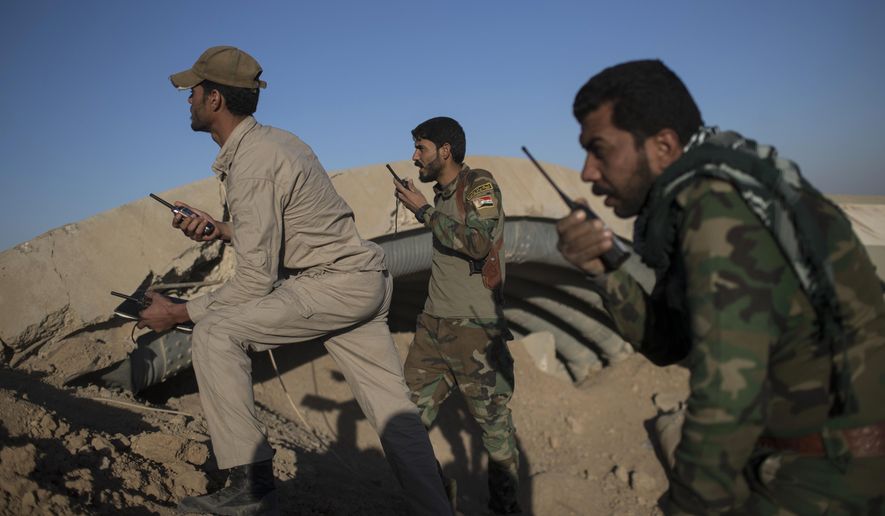Iran’s top military officer signed agreements in Syria last month that will keep Iranian forces there indefinitely with a pledge to help the Bashar Assad regime rebuild damaged military bases, according to the main opposition group to Tehran’s Islamic rulers.
Maj. Gen. Mohammad Bagheri, who became the armed forces chief of staff last year, was photographed in Aleppo visiting Iranian forces and viewing other conflict areas, according to the National Council of Resistance of Iran. Iran, and intense Russian aerial assaults, played a big role in what critics say was a brutal siege of the city that broke the back of anti-Assad rebel forces in the west.
Behind the scenes, Gen. Bagheri and his staff met three times with Mr. Assad and his high command, the National Council says in an intelligence report.
During Syria’s 6-year-old civil war, Tehran has deployed its Islamic Revolutionary Guard Corps and Quds Force operatives, as well as surrogate Shiite militias, some from Iraq. Iran justifies its growing — and apparently permanent — presence in Syria by claiming it is fighting the Islamic State and other Sunni terrorist armies.
If the National Council’s report is accurate, then Gen. Bagheri’s agreement signals that Iran is fulfilling a strategic goal of stretching a “Red Crescent” of domination west from Tehran through Iraq, Syria and Lebanon to Israel’s doorstep.
“The trip was carried out to sign a formal military agreement with Assad dictatorship and to provide a legal and international justification for the presence of the IRGC in Syria and the reconstruction of some of Bashar’s weapons factories by the IRGC inside Syria,” said National Council spokesman Shahin Gobadi.
Asked about the National Council report, a U.S. intelligence official told The Washington Times: “We are aware of Bagheri’s travels, including to Aleppo, but cannot comment on the purpose of his travel. Generally speaking, Iranian investments — in money, influence and lives — to sustain Assad indicate Iran plans to maintain its presence in Syria post-conflict.”
The purported Iran-Syria military agreement runs counter to the U.N. desire to move all foreign forces out of Syria.
The National Council’s intelligence report states:
• On orders from Iranian Supreme Leader Ayatollah Ali Khamenei, Gen. Bagheri met with Syrian President Bashar Assad and his defense minister. They signed an agreement “for the continuation and expansion of the presence of the IRGC in Syria and the creation of a legal and international justification for this presence.”
• A second agreement calls for the construction of bases and weapons factories, and the delivery of new arms. (The BBC reported that satellite photos show an Iranian base being built outside the Syrian capital of Damascus.)
• A third agreement sets plans for the Assad government to repay Iran for some military costs.
“As the Iranian Resistance has repeatedly stated, the only way to achieve peace and tranquility in the region and end the Syrian crisis is to evict the mullahs’ regime from the region, and to expel the IRGC and its militant mercenaries from Iraq, Syria and Yemen, and to prevent the transfer of forces and weapons by the mullahs’ regime to these countries,” the National Council said.
The Iranian resistance group has a good track record of identifying Iranian nuclear and missile sites ahead of Western intelligence. It contends that Iran is violating the Obama-era nuclear deal. The council cites sources inside Iran who say nuclear component work continues at black military bases off limits to U.N. inspectors.
‘Prelude to a Middle East war’
The U.S. intelligence community, however, has reported consistently that Iran is abiding by the deal’s technical requirements.
The pact has not prevented Iran from developing and testing ballistic missiles that one day could carry nuclear warheads. It also has not suppressed Iran’s regional ambitions, which, if anything, have accelerated this year in Yemen, Iraq and Syria, as well as Lebanon via its proxy Hezbollah. The militant group Hezbollah also fought in Syria against anti-Assad rebels.
President Trump has reversed the Obama administration’s nonconfrontational diplomacy toward the ruling mullahs. On Oct. 13, he announced he was decertifying, but not terminating, the Iran nuclear deal and called on Congress to fix it.
“I am announcing today that we cannot and will not make this certification,” Mr. Trump said. “We will not continue down a path whose predictable conclusion is more violence, more terror and the very real threat of Iran’s nuclear breakthrough.”
Under the 2015 agreement, Iran would be free to start assembling nuclear warheads in eight years.
Mr. Trump also rattled Tehran on another front: The Treasury Department added the IRGC to its anti-terrorism sanctions list for supporting militants such as Hezbollah, Hamas and the Afghan Taliban.
The IRGC is the most dominant force in Iranian society. It assures the regime’s survival through continuous oppression of dissidents and is taking control of larger sections of Iran’s economy.
Mr. Gobadi, the National Council spokesman, said Mr. Trump’s tough words and actions against Iran have “caused concern and anxiety among the IRGC.”
He said Ayatollah Khamenei is sending Gen. Bagheri on a regional tour to advocate Iran’s foreign policy and shore up support from Turkey, Russia and others.
Michael Rubin, a Middle East analyst at the American Enterprise Institute, said: “Iran’s ambitions for Syria are no secret. For all the Third Worldism of its official rhetoric, Iran is a 21st-century imperial power seeking to gobble up colonies in all but name. It is not an altruistic power fighting ISIS or others for the sake of defeating terror, but rather because they give an ‘in’ to exploit.”
Iran’s ultimate goal in Syria, he said, is to position forces to achieve a long-standing national objective: the destruction of Israel.
“The danger now, of course, is that the diplomatic quest for quiet will lead governments to get behind the idea of de-escalation zones, which effectively allow Iran to consolidate its gains and prepare for the next round of its goal to defeat Israel once and for all,” Mr. Rubin said. “This isn’t the end of the Syrian civil war, but rather the prelude to a much greater Middle East war.”
Mr. Trump said Tuesday that he held a 90-minute phone conversation with Russian President Vladimir Putin that touched on bringing peace to Syria. Mr. Putin ordered his ground and air forces into Syria at a time when Mr. Assad’s hold on power was slipping. NATO accused Mr. Putin of indiscriminately bombing civilian targets.
The war has left a muddled Syrian map. The Assad government, with Iranian and Russian forces as backup, control much of the west. Anti-Assad rebels, with a limited number of U.S. ground forces and coalition bombing support, now reside in the east closer to the Iraq border in areas once ruled by Islamic State.
The Office of the Director of National Intelligence’s latest report on Iran said, in part: “We assess that Iran’s leaders intend to leverage their ties to local actors in Iraq, Syria and Yemen to build long-term Iranian influence in the region. Iran will also utilize its relationship with Moscow to try to expand Iranian influence and counter U.S. pressure.”
• Rowan Scarborough can be reached at rscarborough@washingtontimes.com.




Please read our comment policy before commenting.